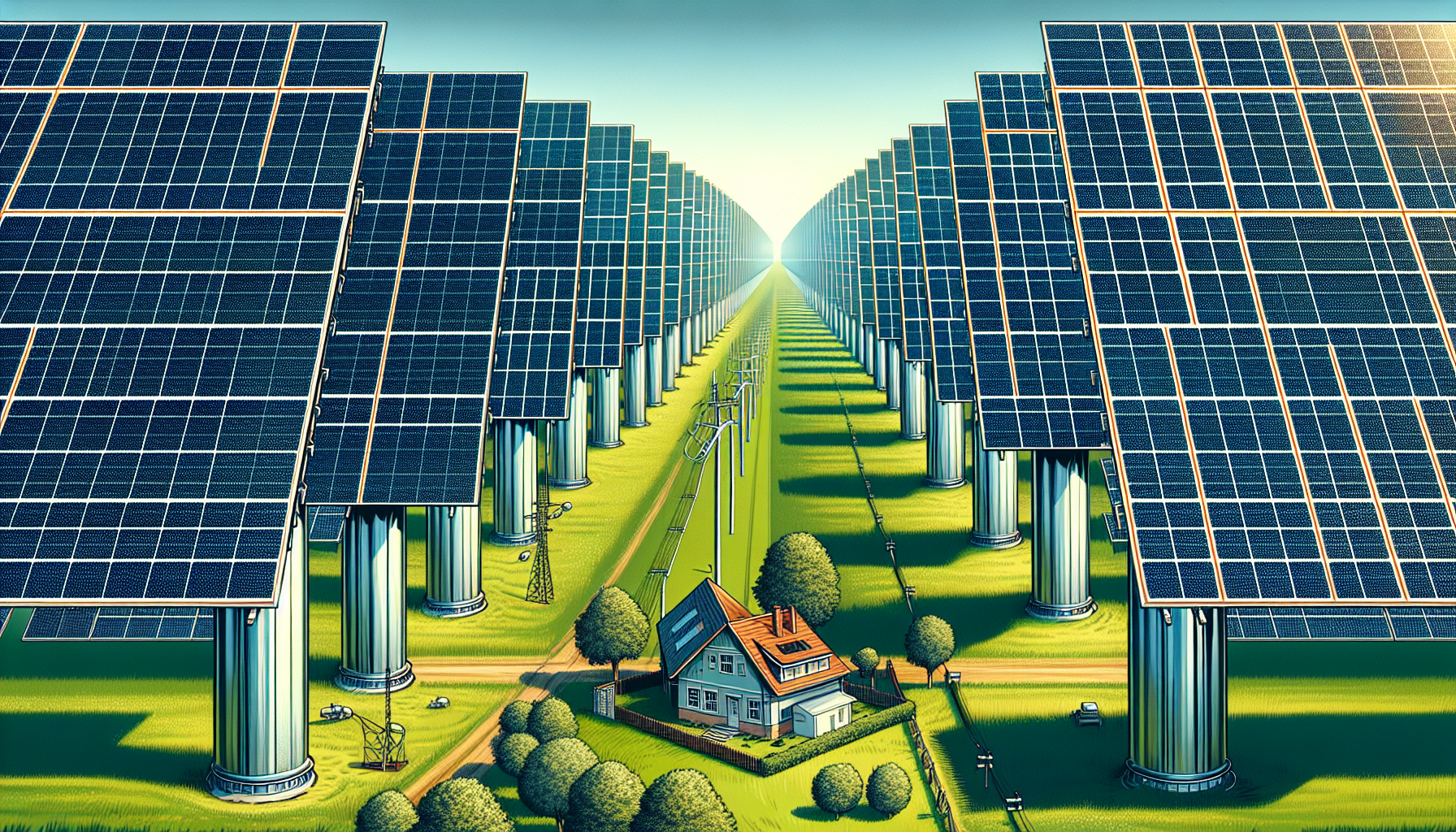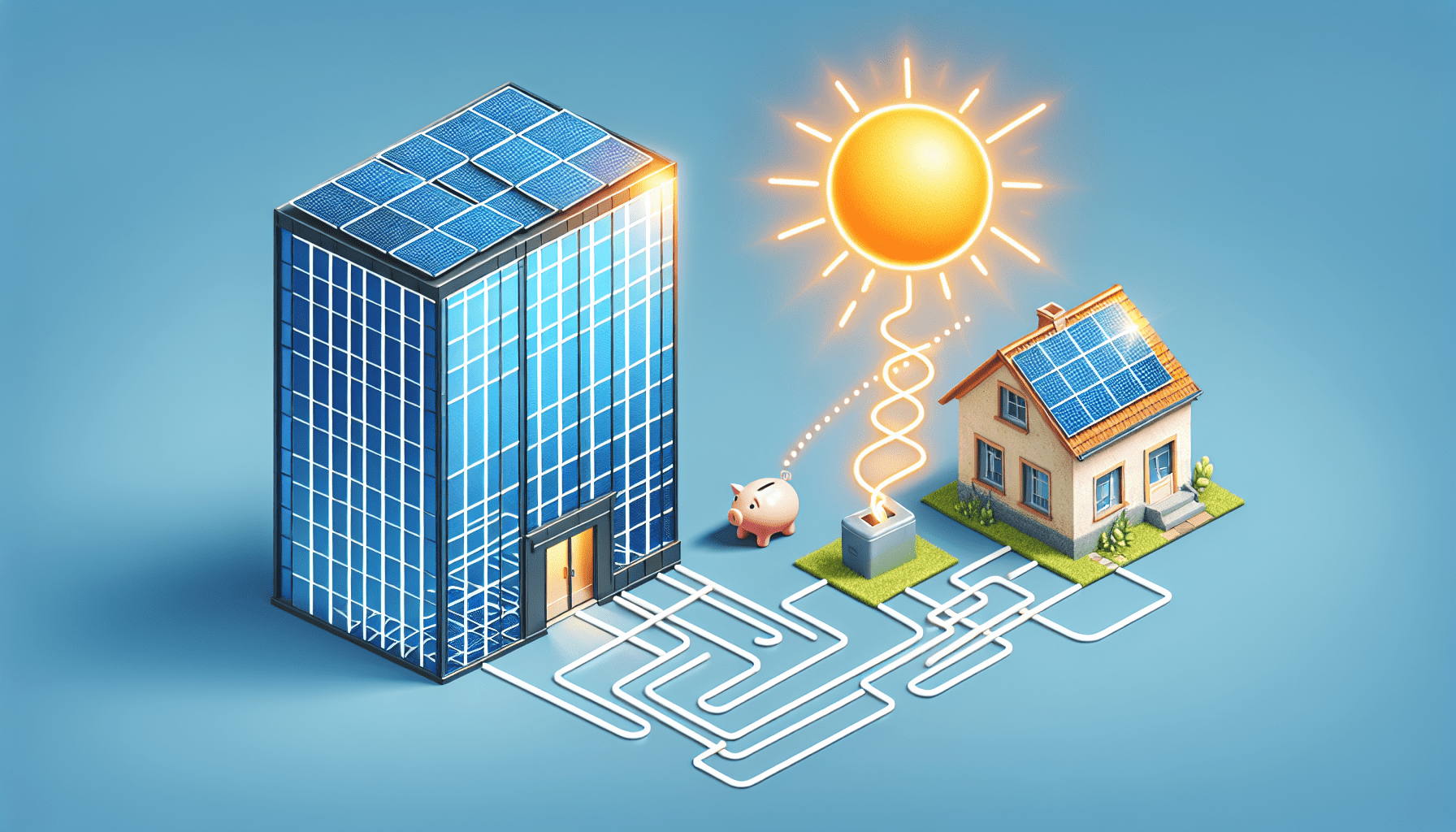When it comes to harnessing solar energy, selecting the right type of solar panel—commercial vs residential solar panels— for each application is crucial. This comparative guide directly examines critical differences that influence the decision-making process, such as initial costs, scale, power output, and installation requirements. Prepare to uncover tailored insights that assist in determining the most suitable solar solution for your energy needs.
Key Takeaways
- Commercial solar systems are larger and more powerful than residential ones, catering to higher energy demands of businesses, involving more cells and more complex installation processes, while residential systems are designed for individual households with lower energy consumption and simpler installations.
- The financial investment in solar systems differs for commercial and residential setups; commercial projects can be costly with a longer payback period but offer larger returns and benefits, while residential solar provides quick payback and significant long-term savings through reduced electric bills.
- Solar panels contribute significantly to environmental sustainability by reducing greenhouse gas emissions and supporting the local power grid with renewable energy; the type of solar solution best suited for an individual or business depends on specific energy needs, financial capacity, and environmental goals.
Understanding the Scale: Commercial vs Residential Solar Systems

When we speak of solar solutions, we’re talking about two distinct applications in the green energy arena: commercial and residential solar systems. Each plays a pivotal role in the quest for renewable energy, but they differ in capacity, application, and scale. Commercial systems are the heavy lifters, designed to meet the voracious energy appetites of businesses, while residential systems cater to the modest needs of homes.
Commercial solar panels, also known as commercial solar panel systems, are the titans of solar energy. They generate a staggering amount of electrical power, eclipsing the output of their residential counterparts. This is largely due to their more considerable size and the higher number of cells they boast.
On the flip side, residential systems, with their less direct sunlight exposure, are tailored for smaller energy demands, making them the perfect choice for individual households. Compare the best solar solutions and discover the incentives for solar in Seattle for both commercial and residential installations.
Size and Power Output
The adage ‘size matters’ holds true when it comes to solar power. Commercial solar panels are not just larger, they are the Goliaths in the solar world, designed to provide more energy and enough power to keep businesses running smoothly. This size difference is not merely for show; it translates into a higher energy output, vital for the power needs of bustling commercial enterprises.
In terms of dimensions, commercial solar panels typically dwarf residential ones, with a standard commercial panel boasting 96 solar cells and measuring a robust 78 inches by 39 inches. Residential panels, on the other hand, usually consist of 72 solar cells and measure a more compact 65 inches by 39 inches. It’s this larger size that affords commercial panels the capacity to generate more power, fitting for the high-energy demands of the corporate world.
Installation Space Requirements
The installation process of solar panels is a tale of two contexts. Commercial panels demand a space that can support their heft, often finding their home on expansive rooftops or as sprawling ground-mounted arrays. They use sophisticated ballasted or attached racking systems, depending on the roof’s structure and the available space,.
In contrast, residential installations are tailored to the more limited space of residential homes, often nestled on rooftops and designed to blend with the aesthetics of the property. The key differences between residential and commercial solar installations are:
- Residential installations are smaller in scale and less complex than commercial setups.
- Residential installations are typically located on rooftops.
- Residential installations are designed to blend with the aesthetics of the property.
- The installation time for residential solutions is typically shorter than for commercial installations.
Energy Needs and Consumption
The energy landscape of commercial properties is vast and demanding. Commercial solar systems are engineered to generate a significant amount of electricity, approximately 800-1,400 kWh per year for each kilowatt of solar panels installed, to match their larger energy needs. This is a critical consideration, as the local electrical lines must be capable of handling the solar feedback to prevent potential issues.
Residential systems, however, are designed for a different rhythm of life. A typical residential solar panel system can generate around 1,000 kWh per year for each kW of solar panels installed, efficiently satisfying the needs of a household. As a result, residential properties often require fewer panels to meet their lower energy requirements, shaping the system design and the number of panels needed.
Investment and Returns: Cost Implications for Commercial and Residential Solar

Venturing into solar energy is a financial journey with diverse paths for commercial and residential systems. The investment in commercial solar projects can be substantial, ranging anywhere from $100,000 to over $1 million for larger buildings. Yet, it’s an economic odyssey that promises lucrative returns, with federal tax credits and depreciation benefits sweetening the deal for businesses.
Residential solar, while less expensive, is equally enticing. Homeowners can embrace solar power with the prospect of reducing their electric bills for the lifetime of their system, after overcoming the initial investment hurdle. While access to financing for commercial solar projects may be less developed, options like solar PPAs allow businesses to save on electricity costs without owning the solar panels outright.
Initial Investment and Payback Period
The financial journey into solar includes:
- The initial investment and the anticipation of the payback period
- Commercial solar projects benefit from lower costs per watt, thanks to economies of scale and bulk purchasing, which can result in higher returns on investment
- Residential solar panels offer homeowners a payback period that typically spans six to ten years, providing a relatively quick return on their solar investment.
For commercial solar systems, the payback period can range from 5 to 13 years, with an average return on investment between 10 to 20%. This makes commercial solar an attractive proposition for businesses looking to make a long-term investment with substantial financial rewards.
Long-term Savings and Benefits
The promise of long-term savings is a powerful motivator for both commercial and residential solar adopters. Commercial solar installations offer the following benefits:
- Reduce ongoing energy expenses
- Enhance the value of commercial properties
- Some states witness an average return on investment higher than 10%, outperforming many traditional investment avenues.
Homeowners, too, can revel in the financial freedom that follows the initial payback period. The prospect of reduced electric bills for the life of their solar panel systems is a compelling argument for residential solar panels, offering significant long-term cost savings.
Technical Aspects and Efficiency: Equipment and Performance

The technical tapestry of solar systems is rich and varied, with commercial installations boasting more sophisticated equipment and specialized components. Commercial solar panels typically exhibit a higher efficiency, around 19.6 percent, compared to the 18.1 percent efficiency of residential solar panels. This difference is a testament to the specialized needs of businesses that demand robust and efficient energy solutions.
Residential systems, while less complex, are designed with simplicity and user-friendliness in mind. They cater to the everyday energy needs of homeowners without the added intricacies of commercial systems. The larger scale and higher electrical ratings of commercial equipment contribute to the complexity of these installations.
Panel Technology and Efficiency
At the heart of every solar solution lies the technology that drives its efficiency. Solar panels convert sunlight into direct current energy, which then stimulates electrons to move through the cells of the panels. Higher efficiency panels convert more sunlight to electricity, a key factor in determining the appropriate solar solution for both commercial and residential properties,.
The technological differences between commercial and residential solar panels, such as the size and arrangement of solar cells, directly impact their efficiency ratings. These distinctions are crucial when considering how many panels are needed to meet specific energy requirements.
System Components and Complexity
Delving into the components of solar systems reveals the complexity of commercial installations. These projects demand an in-depth understanding of electrical systems and the use of specialized, high-rated electrical equipment. The intricacies involved in commercial solar projects, such as considering transformer upgrades and evaluating local line capacities, require expert knowledge to navigate.
Commercial solar installations also rely on robust racking or mounting systems to securely attach solar panels to the roof, an essential component of the overall commercial solar system. These technical considerations set commercial solar apart, demanding more expertise and intricate planning than residential systems.
Maintenance and Durability
The story of solar panel maintenance and durability is one of resilience and long-term performance. Modern photovoltaic solar panels are designed to retain at least 80% efficiency for a minimum of 25 years, signifying their enduring nature. Warranties, which can range between 25 to 30 years, offer peace of mind, guaranteeing prolonged energy cost savings.
Commercial solar panels, although designed for minimal maintenance, may require more intricate care due to their larger scale and complexity. Regular cleaning and annual inspections are advised to maintain performance and hardware integrity, making commercial solar panel installation a crucial aspect to consider.
Residential solar upkeep is similarly minimal, but homeowners must remain vigilant in cleaning and removing obstructions to preserve efficiency. Awareness of the expected lifespan and diminishing efficiency over time is crucial for ensuring that residential solar panels continue to meet energy needs.
The Installation Journey: From Planning to Power On

The journey of installing solar panels includes the following steps:
- Site evaluation
- System design
- Permitting
- Activation
Both commercial and residential installations follow this sequence, though commercial installations typically require more time due to their scale and complexity.
A thorough site assessment kicks off the journey, setting the stage for a successful installation. This critical step involves measuring the site, reviewing conditions, and finalizing installation plans. From there, the construction phase unfolds, culminating in a solar system that’s ready to harness the sun’s power.
Site Evaluation and Design
The site evaluation and design phase is a critical juncture in the solar installation journey. For commercial projects, this involves a comprehensive review, including planning for grid connection, shade analysis, and various surveys. A site technician plays a pivotal role in ensuring the accuracy of measurements and the feasibility of the installation plans.
Design drawings for commercial solar installations serve several important purposes:
- They crystallize the vision for panel placement
- They provide a detailed construction outline
- They include permit and construction drawings
- They ensure that the final design meets both technical and aesthetic requirements of the project
This level of detailed assessment is essential for a successful commercial solar installation.
Permitting and Regulations
Navigating the landscape of permitting and regulations is an integral part of the solar installation journey. For commercial solar contracting, enlisting a high-quality engineering firm or an experienced in-house designer is crucial to ensure technical competence and expedite the permitting process. The review process for commercial installations can be intricate, often involving multiple revisions and detailed planning to ensure accurate document submission.
After installation, an inspection by the city is required to affirm that the solar system complies with local codes. Additionally, commissioning ensures that the system meets performance expectations and gains approval to connect to the local power grid,. It’s important to note that permitting requirements for solar panel installation can vary by location, but they are a vital consideration in the overall process.
Installation and Activation
The actual installation process for commercial solar projects can span from six months to a year due to their sheer size and the complexities involved. The construction phase alone can range from 6 to 12 weeks, depending on the project’s scope. Residential installations, in contrast, are typically completed within a single day, making them a swift and efficient transition to solar energy.
Activation of both commercial and residential solar systems is a momentous occasion, often as simple as flipping a switch to begin harnessing solar power. This final step marks the culmination of a journey from planning to power on, and it’s where the solar experience truly begins to shine.
Going Green: Environmental Impact and Renewable Energy Contributions

Adopting solar panels is more than just an energy decision; it’s a commitment to environmental sustainability. By tapping into renewable resources, solar energy:
- Reduces reliance on finite fossil fuels
- Curtails greenhouse gas emissions
- Helps to conserve the environment
- Reduces the demand for electricity from non-renewable sources
Both commercial and residential solar systems play a pivotal role in this green revolution, with residential solar projects being a significant contributor.
Moreover, commercial solar systems can amplify a company’s brand reputation by showcasing a dedication to sustainable energy practices. This commitment to the environment resonates with consumers and stakeholders alike, elevating the company’s standing in the community and within their industry.
Reducing Carbon Footprint
The environmental narrative of solar energy is deeply intertwined with the concept of reducing the carbon footprint. A single solar panel can offset over 100 tons of carbon dioxide emissions throughout its 28-year lifecycle, making a significant impact in the fight against climate change. When compared to traditional energy sources like coal, which emits 0.97 kilograms of CO2 per kilowatt-hour, solar panels have a much lower carbon footprint, between 20 to 50 grams of CO2e per kilowatt-hour.
This drastic reduction in emissions is a testament to the clean energy produced by solar panels, whether installed on commercial or residential properties. By opting for solar, property owners contribute significantly to the global effort to mitigate greenhouse gas emissions and promote a healthier planet.
Supporting the Local Power Grid
Solar installations not only benefit individual homes and businesses but also bolster the collective resilience of local power grids. By generating electricity during peak demand periods and contributing excess energy back to the grid, solar panels play a key role in grid stability. This dynamic interaction with the power grid ensures that surplus energy is absorbed when production exceeds demand, and additional power is supplied during times when solar output is insufficient.
Artisan Electric’s commitment to enhancing the Seattle region’s local power grid through renewable electricity projects exemplifies the broader impact of solar energy. By promoting clean energy and lowering electric bills for consumers, solar installations provide a dual benefit that echoes throughout local communities and economies.
Tailoring to Your Needs: Which Solar Solution Fits Your Profile?
Finding the perfect solar solution is a personalized affair, one that hinges on your unique energy needs, budget, and potential savings. Whether it’s the allure of cutting energy costs or offsetting higher energy consumption, solar panels offer a tailored approach to energy independence,. The decision to go solar is nuanced, involving factors such as sunlight exposure and the financial benefits of reduced energy bills.
For those considering solar, weighing the benefits of purchasing versus leasing panels is crucial. Purchasing may unlock tax advantages and greater long-term savings, while leasing can provide a lower upfront cost. Regardless of your choice, Artisan Electric is here to guide you through assessing your solar needs, whether commercial or residential, ensuring you find the best solar energy solution for your situation.
Summary
Navigating the solar panel landscape can be akin to charting a course through uncharted waters, but armed with knowledge of the differences in scale, cost, technical aspects, installation processes, and environmental impacts, you are now well-equipped to make an informed choice. Whether you represent a business or are a homeowner, the journey to solar energy is one of significant benefits, long-term savings, and a greener planet. Let this be your clarion call to action, an invitation to join the ranks of sustainable energy pioneers and make a lasting difference for generations to come.
Frequently Asked Questions
What sets Artisan Electric apart in the solar installation industry?
Artisan Electric stands out in the solar installation industry due to our full-service turn-key approach, commitment to quality installations, holistic energy solutions, exceptional customer service, and a strong local reputation, particularly in the Seattle area. These factors contribute to our distinction in the industry.
How long do solar panels last, and what warranty does Artisan Electric offer?
Artisan Electric offers a warranty that guarantees system production and workmanship for a duration of 25 years, with product warranties extending up to 30 years.
Can Artisan Electric provide solutions for electric vehicle (EV) charging?
Yes, Artisan Electric is a Certified Tesla EV charger Installer and offers top-notch solutions for EV charging installations, staying updated on the rapidly evolving EV charger market.
Are there financial benefits to installing solar panels for commercial properties?
Yes, installing solar panels for commercial properties can bring significant financial returns, with benefits such as tax credits, depreciation advantages, reduced energy expenses, and potentially increased property value. These contribute to long-term cost savings.
How does solar energy support environmental sustainability?
Solar energy supports environmental sustainability by reducing reliance on finite fossil fuels and decreasing greenhouse gas emissions, contributing to a more sustainable future.
